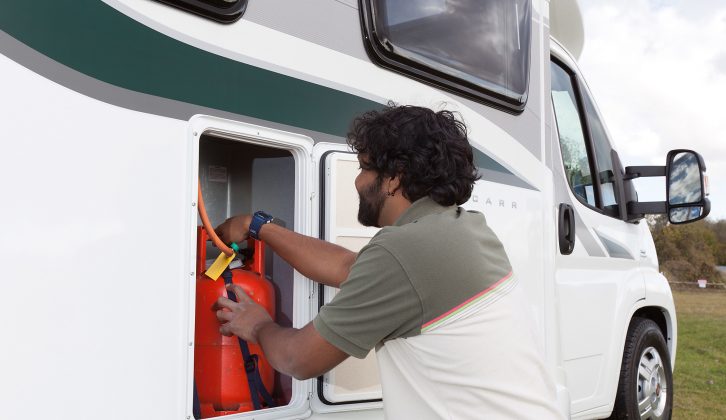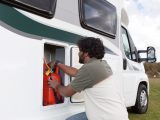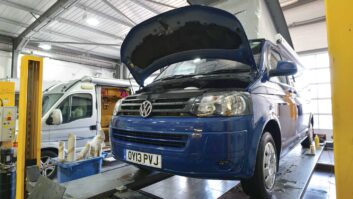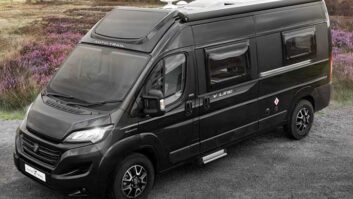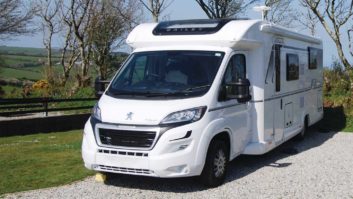Many motorhome-owners have switched from using Calor gas cylinders to user-refillable ones, or even bulk tanks mounted to the chassis. Yet there’s still confusion over what the actual gas is! Some people talk about propane or butane and others call it LPG. It’s time to clear these terms up.
Propane and butane are both gases derived from crude oil, as by-products of the petro-chemical industry. Both are LPG (which simply stands for Liquified Petroleum Gas), once they are compressed into liquid form. Let’s look at the different types of LPG available to you.
Blue for butane, red for propane
Using Calor gas cylinders as a guide, red contains propane, and blue contains butane. However, this is not an industry standard: other brands use a different colour-code.
Butane has a higher calorific value than propane (this simply means it contains more energy for a given unit of volume) and is stored in liquid form at a lower pressure than propane (28psi compared to 100psi) so it sounds like an ideal fuel for motorhome heating and cooking appliances. Well it is – if you only use your motorhome in warm weather!
For winter camping, butane will let you down, simply because it won’t boil below about 2°C.
Why does gas have to boil at all?
Remember the fuel is stored as a liquid, under pressure in the cylinder. When you open the take-off valve (or connect a regulator) and start drawing off gas, the pressure in the cylinder reduces and the liquid gas boils to produce more fuel in gaseous form. For this to work, the liquid fuel needs to be above its boiling point which for propane is -42°C while butane is -2°C. So propane is the best gas to use for all-year-round camping.
What’s in your LPG tank?
So what is the LPG sold at Autogas pumps, then? Well, in the chilly UK it is almost completely propane but in some mainland European countries it can be up to 50 per cent propane and 50 per cent butane. That’s because it is intended as road fuel: as such, it is drawn off the tank in liquid form and vapourised in a heated unit in the engine bay.
Running a butane-propane mix for domestic fuel can present problems in colder climes: the butane content raises the boiling point of the propane while the propane content lowers the boiling point of the butane, slightly.
What can happen in sub-zero conditions is that the propane gets burned off first, leaving a higher proportion of butane, which won’t boil and produce usable gas vapour. So beware if you use refillable systems and try to fill up in the UK.
Heater upgrades are in vogue
We recently had a week of heater jobs in my motorhome workshop. First I upgraded a 2KW Webasto to a 4KW Eberspacher; not a difficult job, but time-consuming. I fitted the Webasto unit a few years ago for the customer as his Alde wet central heating took too long to warm the ‘van up from cold. Well, the customer got this Eberspacher at a good price and since he’d found that the 2KW Webasto still took time to warm up his nine-metre motorhome, the upgrade choice was what is often called a ‘no brainer’.
Next we had a Romahome with a retro-fitted Propex 2000 unit that was playing up. It was lighting up, but I found a constant flame-failure fault. It had only been fitted 11 months previously, so I sent him back to his installer for a warranty repair.
Pops, bangs and ignition failure
The third heater problem was more involved. It was a Hymer S820 with Truma’s C-series heater that wouldn’t ignite cleanly. Instead, it would pop and bang a few times then go to a fault condition.
In the workshop, it fired first time, but then went into the fault condition. First I rang Truma’s technical guys; they know these units inside-out and always diagnose correctly over the phone for me. They said it might be low gas pressure or a fault in the burner assembly. I disconnected it from its gas supply and tried a fresh bottle with a brand new regulator. The same fault occurred, so out it had to come. This proved difficult: its locker has a nice big door… but the flue connection is behind the heater and the heater is 25mm taller than the door! I had to remove the heater’s top cover to get it out.
Once out, it took ten minutes to strip out the burner assembly and all was revealed: the igniter electrodes and flame rectification electrode were badly burned away.
This damage is typical of a unit that’s being used continuously, such as when ‘full-timing’. It turns out the owners are living in the ’van while they build a house – and the previous owners used it full-time, too.
Now you’re cooking with gas. And if not, check out John Wickersham’s advice on maintaining gas hobs.
Propane and butane are both gases derived from crude oil and both are LPG once they are compressed into liquid form
